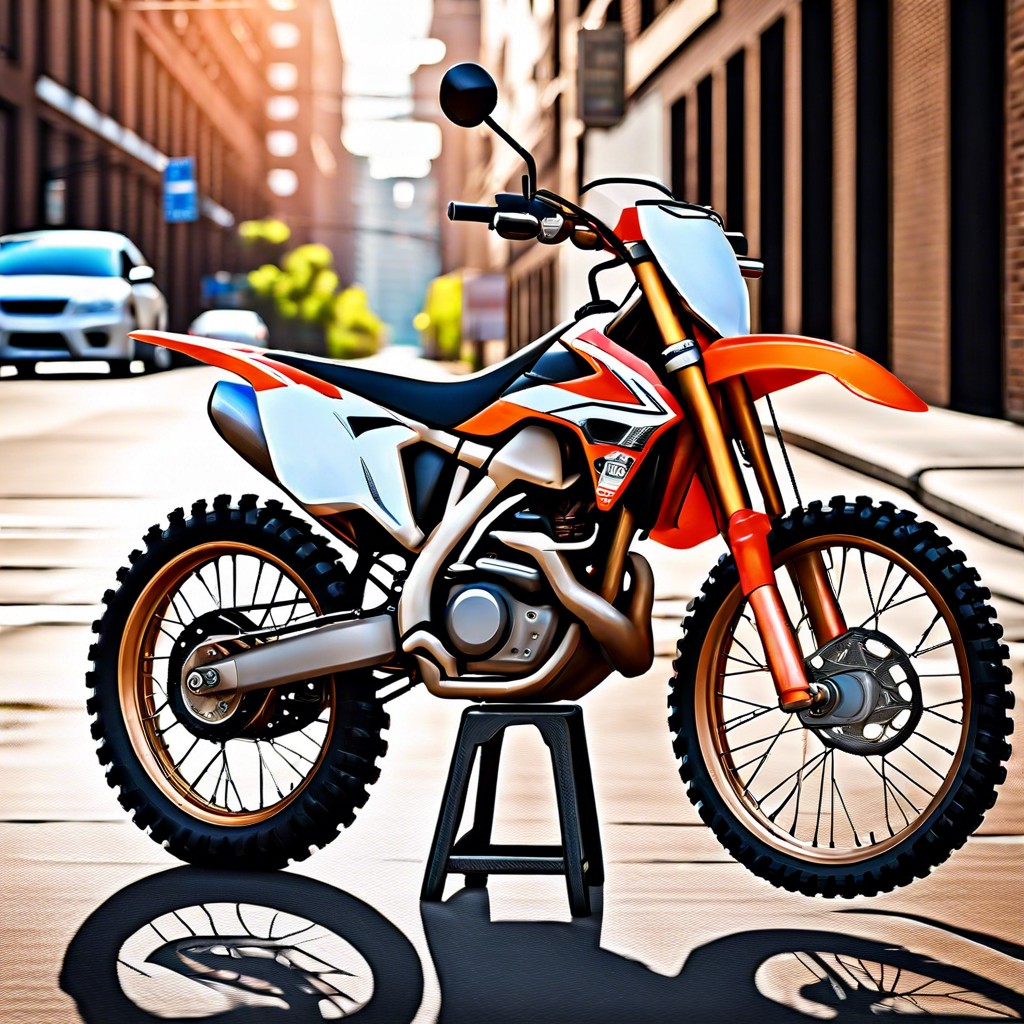Discover whether you can legally take your dirt bike for a spin on public roads and what it takes to make that happen.
Key takeaways:
- Dirt bikes can be made street legal with certain modifications.
- Each state has its own regulations for street-legal dirt bikes.
- Headlights and tail lights must meet specific requirements.
- DMV approval and documentation are necessary for street legality.
- Texas has specific requirements for making dirt bikes street legal.
Legal Issues: Rumors and Facts

Navigating the legal labyrinth of roadworthiness for dirt bikes, it’s crucial to separate hearsay from fact. For instance, one common myth assumes all dirt bikes are off-limits on public roads; however, the reality is nuanced. While stock models come primed for off-road use, certain modifications can bring a bike up to snuff with street legal standards.
It’s the precise regulations—often varying by state—that dictate the alterations needed. Beyond adding essential lighting and signaling devices, licensing procedures and emissions requirements must be met. In short, the road to legality starts with understanding specific state mandates and transforming your dirt bike to fit the mold.
Did you catch the news about that guy who swore his dirt bike was street legal because he slapped on a rearview mirror? Don’t fall for such tall tales! Always check with the Department of Motor Vehicles for the final word on the legitimacy of your bike’s street status. Remember, hearsay won’t hold up in a traffic stop.
Headlight
Switching gears to visibility, taking a peek at your bike’s front end is paramount. A clear path ahead not only guides your twilight escapades but ensures you’re seen by fellow road-goers. By law, your dirt bike needs a headlight with both high and low beams to be street-legal. These beams are not just a light-hearted suggestion; they signal your intentions and illuminate the night.
There’s a twist, though; this isn’t your run-of-the-mill flashlight strapped to the handlebars. The lights should be DOT approved, signifying they meet rigorous standards. Some states have specific requirements for the headlight’s operational duration, often insisting it must run for a certain period solely on battery power. So, before you rev up and ride into the sunset, check those specs! With a proper headlamp, you’re literally shining a spotlight on your street-legality progress.
Tail Light
A proper tail light is paramount for dirt bikes transitioning to street-legal status. For starters, the light must be visible from a significant distance, typically at least 500 feet to the rear, ensuring drivers behind can see your bike, especially at night or during inclement weather. Additionally, the tail light must incorporate a brake light with a distinct difference in illumination when the brakes are applied.
Many states also demand that the light assembly includes a license plate illuminator. This small, often overlooked feature is crucial for nighttime visibility of your registration tag. Keep in mind, off-road models don’t come with this equipment, so an aftermarket installation may be necessary. This step separates dirt-only bikes from their street-legal cousins, reinforcing safety and compliance with the law.
DMV Approval
Crossing the T’s and dotting the I’s with the Department of Motor Vehicles (DMV) is a critical step in the transformation of a dirt bike to a street-legal chariot. Before you hit the pavement, the DMV requires proof that your bike complies with road safety standards. Let’s shed some light on the specifics:
- Inspection: Schedule a thorough inspection with authorized personnel. The DMV wants to know your bike is safe for road use, from brakes that could stop on a dime to tires that grip the tarmac like a clingy koala.
- Documentation: Arm yourself with the necessary paperwork. Expect to present evidence of ownership, a bill of sale, or a manufacturer’s certificate of origin. It’s less hide-and-seek and more show-and-tell.
- License Plates: In the eyes of the law, a bike without a license plate is about as street legal as a cardboard cutout of a cop. Secure number plates by submitting an application along with the inspection certifications.
- Insurance: Equip your dirt bike with insurance to safeguard not just the bike, but also your peace of mind. Without it, you might as well be trying to catch the wind in a net.
Remember, the DMV won’t give your dirt bike a gold star and a pat on the back until it’s up to code. Playing by their rulebook keeps your off-road beast from being caged.
Are Dirt Bikes Street Legal in Texas?
In Texas, dirt bikes must adhere to several street-legal requirements before hitting the pavement. First, your bike needs a suitable headlight with high and low beams for visibility after dusk. A red tail light, visible for a minimum of 500 feet, is also non-negotiable for night riding.
Moving on, a horn audible from 200 feet ensures you grab the attention of other road users. Now, don’t forget the rearview mirror; it offers a clear line of sight to whatever’s cooking behind you. And yes, your rubber needs to be DOT-approved—off-road knobs won’t cut it here.
Registration and inspection are your final pit stops. After decking your bike with the necessary gear, head to the DMV for validation. Securing a street-legal title and plate is like grabbing the golden ticket to explore the Lone Star State’s asphalt expanses with your dirt bike. Keep in mind, while the process might take some elbow grease, the payoff is the unfettered freedom of the open road.